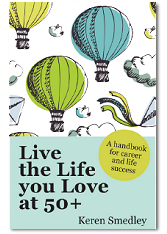Keren Smedley 30th August 2016
For tips and regular newsletter: ‘Feel younger, look and enjoy life more’
Coaching – Trying to make sense of your life and the roles you play
 As many of you know I work as both an executive and business coach and a personal coach. When people come to see me personally it is often because they are trying to make sense of their lives and the roles they play. I thought I would share with you an exercise that many find helpful
As many of you know I work as both an executive and business coach and a personal coach. When people come to see me personally it is often because they are trying to make sense of their lives and the roles they play. I thought I would share with you an exercise that many find helpful
Exercise: Where am I in my family?
I expect it is a long time since anyone asked you to draw your family.This exercise involves a bit of drawing. You do not need to be an artist to do this and, remember, no-one is looking! You are going to do three pictures or diagrams:
- Draw a picture of your family, put in whoever you see as part of it, pets included. (Draw them as stick people if you want.) Add any distinguishing features you think are relevant – for example, a walking stick for a parent or a pram for a baby.
- Now put that aside and draw a circle in the middle of the page and put yourself in the middle.
 Around your circle place all the people who are in your family. (You may find more people pop into your mind than you had in the original picture; if that happens, add them in and just make a note as you may want to come back to them later), put those you are close to nearest your circle and those less involved with you further away. Take a look at the picture and note where your relationships lie. Is this how you want them to be? Or are there people you want to have more contact with than you currently do?
Around your circle place all the people who are in your family. (You may find more people pop into your mind than you had in the original picture; if that happens, add them in and just make a note as you may want to come back to them later), put those you are close to nearest your circle and those less involved with you further away. Take a look at the picture and note where your relationships lie. Is this how you want them to be? Or are there people you want to have more contact with than you currently do? - Now draw an arrow to and from them. If you are the one who gives the care or attention or physical or emotional support, then make the arrow to them thick and the arrow from them dotted. If you are the one who is looked after, then make the arrow to them dotted and the one from them to you thick. If it is equal, the thickness of the line should be the same. Someone such as a baby may not physically look after you but you are emotionally fed so in this case the arrow would probably be even. Do this for all the people. Now, in a different colour, add in your friends, again linking them to you by arrows. You now will have a sense of who you get support from and who you give it to and who is important in your world. You can also add in work colleagues, if you want the full picture.
- We are going to end with a family tree. Again, start with yourself and add in all your family including those who you might not see and who are not included in the above diagrams. Go back as far as grandparents and great- grandparents, if you know about them. Finally, circle the blood relatives. For example, your parents would be circled and your in-laws not, your half-siblings circled and step-siblings not.
In a notebook:
Ask yourself:
- How did you feel doing this? What issues did it raise for you?
- Were you aware of people who weren’t there because they are no longer part of your life, through death, divorce and disputes?
- Do you get as much support as you give?
- Were there people you forgot in the first diagram and remembered in the second? Why was this? Are they the ones you find a burden?
- What feelings did you notice when you drew your family tree and I asked you to separate the blood relations from the others? Was there a difference in the support you felt you got from them?
- Have things sprung to mind just by doing this that you think need resolving or changing? Make a list of them and jot down a plan of action. For example, ‘I haven’t spoken to my brother for months so I am going to call this week.’
(From: Live The Life You Love At 50+ Keren Smedley, published by McGraw-Hill)
 If this exercise has raised some issues for you, you may want to talk to one of our life coaches. Please contact us: [email protected]
If this exercise has raised some issues for you, you may want to talk to one of our life coaches. Please contact us: [email protected]
For tips and regular newsletter: ‘Feel younger, look and enjoy life more’
PS please share this if you think that it might help someone else.
Share this ..

